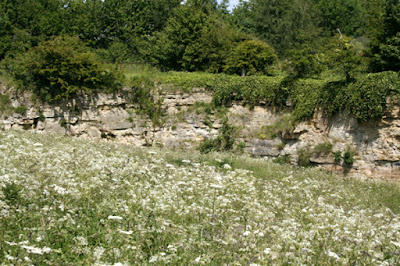 |
| An iron rich Carboniferous sandstone |
I have known about South Elmsall Quarry for many years, through my Geoconservation work in South Yorkshire but, being set in a relatively remote location, it is not easy to get to without a car; not to be deterred, I set off to find this place - using the bus, the train and my own two legs.
 |
| Halfway up the hill |
On Google Map, the walk from Moorthorpe railway station to South Elmsall Quarry looks about 2.5 km. After getting off the train and
walking along relatively flat land to the centre of South Elmsall, and crossing The Beck and the railway line over a continuously spanned bridge, there is a moderately steep escarpment.
 |
| A view up the escarpment |
I have crossed the unconformable boundary between
Carboniferous and Permian strata very many times, whilst exploring the geology and associated ancient monuments along the length of the Magnesian Limestone escarpment; however, on this occasion, the June sunshine was strong enough to make
me wilt slightly, when I thought about the walk ahead of me.
 |
| The geology around Moorthorpe and South Elmsall |
Once I had started
off, I soon came across an outcrop of sandstone – halfway up the hill – that
caught my interest. From
the online British Geological Survey map, I have since learned that this is just noted
as being one of the discontinuous sandstones that form minor topographic
features and are generically described as being part of the Pennine Upper Coal Measures Formation. In
common with many Carboniferous sandstones that can be found all over
the north of England, they exhibit cross-bedding – the product
of strongly flowing rivers – and are rich in iron oxides.
 |
| Ferruginous sandstone |
Moving
on up the escarpment, the unconformity between the Carboniferous and Permian can be inferred by the appearance of an old quarry face that now forms part of a private housing development. A quick look at this section of the Cadeby Formation revealed a succession of relatively thin beds, with the lower section of the exposure being distinctly orange in colour and containing a high proportion of sand, which is typical of the region.
 |
| A detail of the Cadeby Formation |
Walking further up to the brow of the hill, I made a mental note to myself that it is always essential to bring food and drink on a field trip. Fortunately, I was able to take advantage of the conveniently placed local shop and, after drinking some Lucozade, I finally arrived at South Elmsall Quarry.
 |
| A road cutting |






























